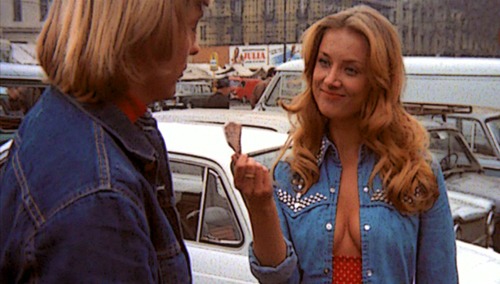Barbara Bouchet’s journey from postwar Europe to the bright lights of Hollywood and later the thriving world of Italian cinema is a story of resilience, adaptability, and artistic reinvention. Born in 1943 in what was then Czechoslovakia, Bouchet emigrated with her family to the United States after World War II, escaping the instability of a war-torn continent. Growing up in America, she embraced the cultural and creative opportunities her new home offered, quickly attracting attention for her striking beauty and engaging screen presence.

Early Years in Hollywood
Bouchet entered Hollywood in the 1960s, a period marked by both artistic experimentation and rigid casting traditions. She quickly landed roles that showcased her visual appeal, including notable appearances in Casino Royale (1967) and Sweet Charity. However, she often found herself typecast as the ornamental “pretty girl,” a common Hollywood limitation placed on women at the time. While these roles brought her visibility, they rarely allowed her to explore the full range of her acting abilities.

Turning Point and Move to Italy
By 1969, Bouchet had grown frustrated with the lack of meaningful parts in the U.S. film industry. Deciding to take control of her career, she moved to Italy, a choice that would prove transformative. The European film scene, especially in Italy, was thriving with genre cinema—crime thrillers, horror films, and giallo mysteries—that offered her the chance to play complex, unpredictable characters.

Rise in Italian Cinema
In Italy, Bouchet became a highly sought-after actress. She brought both glamour and intensity to her roles, starring in critically acclaimed films such as Don’t Torture a Duckling and Shock. These performances demonstrated her ability to blend emotional depth with the bold, often experimental storytelling of Italian directors in the 1970s and 1980s. Her work during this period not only expanded her artistic range but also cemented her status as an icon of European cinema.

Enduring Legacy
Barbara Bouchet’s career stands as a testament to the importance of creative freedom and the willingness to seek opportunities beyond traditional borders. While Hollywood may not have fully recognized her potential during her early years, her legacy thrives in the films she made in Italy, where she was celebrated not just for her beauty but for her talent, versatility, and dedication to her craft. Today, she is remembered as both a Hollywood “what could have been” and a beloved star of international cinema.
